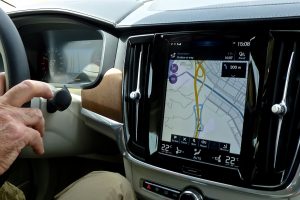Take a roundabout visit to Spain
Filed under: Equinox, Features, Autos
By John Gilbert
ESTEPONA, Spain
Volvo took a roundabout route to developing its impressive new S90 sedan — first building the XC90 SUV, then making the S90 virtually a sedan-size derivative — and the introduction test drive of the carliterally took us on a roundabout route.
The area we visited, along the Spanish Riviera between Malaga and the resort city of Estepona, would seem to indicate that Spain might lead the world in “roundabouts,” those intersection replacements that turn important roadway interchanges into forced-slowdown circles with various inlets and outlets. In congestion, of course, entering a rotary can be dicey and exiting can be more like an escape.
In southern Spain, it seemed as though nearly every exit from a freeway sent you into a roundabout, which in turn distributed traffic in any and all directions. We weren’t aware of all that when we first arrived in Malaga, then rode a coach bus to our luxurious Kempinski Hotel Bahia in Estepona.
Our wave of auto journalists gathered to leave our for dinner at El Pescadoran, where we learned another Spanish tradition. You sit family style, and waiters bring out large platters or bowls of delectable food. Unwilling to leave any, we ate virtually every morsel, then the waiters took the platters away and replaced them with more platters of different delectable items.
The lengthy menu we had seen, briefly, was impressive, but the reason nobody asked us for our selections was they intended to bring us ALL of the selections. Next morning, we had some discussions, and then we were off on Leg 1 of our 4-Leg test drive. Three of the legs would be in S90 sedans, and the fourth in the V90, a slick and sleek station wagon that seems much longer than the sedan, but actually is 3 inches shorter.
My driving partner was Parks McCant, a tall fellow I’d met at the Malaga, Spain, airport, as we joined forces hoping to form a posse that might locate a person wielding a Volvo sign to direct us to a bus that might convey us to our hotel. We struck a quick and easy relationship, and, because he’s 6-foot-6, I knew he would provide real-world evidence of adequate head and legroom in our test cars.
I got behind the wheel first, and after agreeing on the luxurious comfort enveloping us, and the impressive ergonomics of the controls and other features, we were off.
Our start was so intriguing we decided to repeat it three or four times — involuntarily, of course. Instead of the usual direction book, Volvo installed all the turns for the route into the navigation system, which is a great idea. A pleasant, soothing female voice suggested when to get into the right lane, prepare to turn, and then turn.
We only went a mile or so and were instructed to exit. At the top of the exit ramp we found our first roundabout. The Nav Lady told us to take the third exit from the roundabout, which we did. We should have taken the second, but we didn’t know that, so we trusted the instructions.
The highly efficient Nav Lady, with proper Scandinavian courtesy, didn’t tell us we had fouled up, but merely directed us back on course. So we thought we were merrily on our way, following a sequence of directions to cross a bridge to another roundabout, followed by directions to another roundabout, then a third roundabout. That got us back near our starting position, and because it was all pretty unfamiliar, we sailed off again. We followed the same instructions the second time, and it wasn’t until partway through the third lap around the same sequence of roundabouts that we realized we were repeating our mistake.
Somehow, the wrong instruction trapped in a sequel-with-roundabouts of the Bill Murray movie “Groundhog Day,” where the star is destined to repeat everything, day after day, trapped in some cosmic vortex. Read more






 John Gilbert is a lifetime Minnesotan and career journalist, specializing in cars and sports during and since spending 30 years at the Minneapolis Tribune, now the Star Tribune. More recently, he has continued translating the high-tech world of autos and sharing his passionate insights as a freelance writer/photographer/broadcaster. A member of the prestigious North American Car and Truck of the Year jury since 1993. John can be heard Monday-Friday from 9-11am on 610 KDAL(www.kdal610.com) on the "John Gilbert Show," and writes a column in the Duluth Reader.
John Gilbert is a lifetime Minnesotan and career journalist, specializing in cars and sports during and since spending 30 years at the Minneapolis Tribune, now the Star Tribune. More recently, he has continued translating the high-tech world of autos and sharing his passionate insights as a freelance writer/photographer/broadcaster. A member of the prestigious North American Car and Truck of the Year jury since 1993. John can be heard Monday-Friday from 9-11am on 610 KDAL(www.kdal610.com) on the "John Gilbert Show," and writes a column in the Duluth Reader.